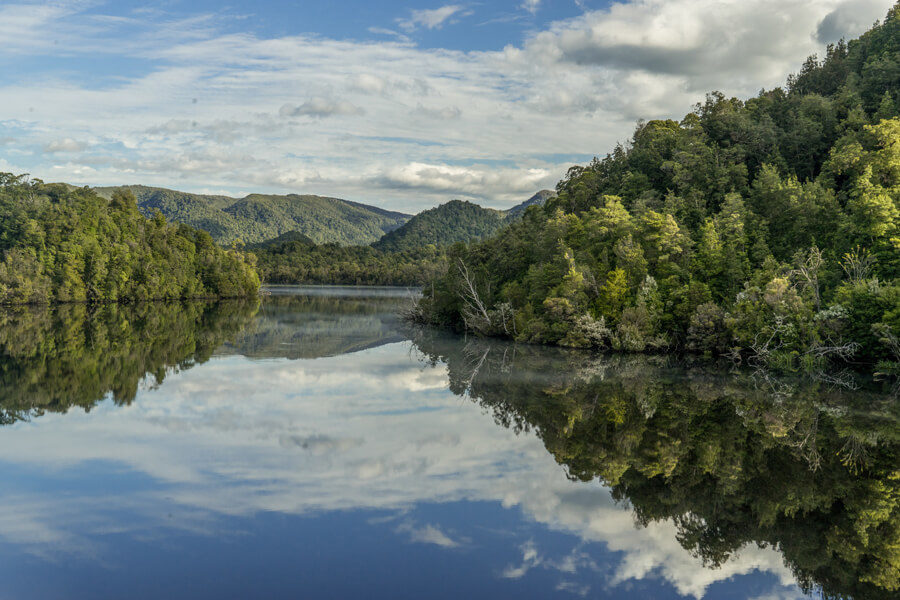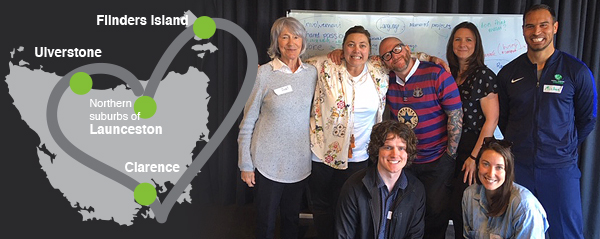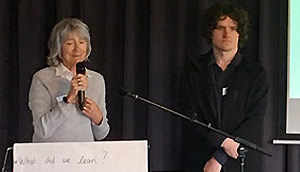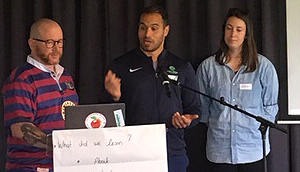How four Tasmanian communities are leading the way in anticipatory care

DATE
TYPE Prevention Centre News
The Anticipatory Care Projects (ACP) Tasmania team and partner organisations converged on Launceston in November for its statewide meeting. The ACP has project officers in Ulverstone, Northern suburbs of Launceston, Flinders Island and Clarence working closely with communities to prevent and manage chronic disease.
The teams from each of the four areas presented their achievements and challenges after a year of working with their communities. The were joined by local community groups, the evaluation team from the Sax Institute, researchers from the University of Tasmania, representatives from the Prevention Centre, and policy makers from the Tasmanian Department of Health.
This is an important opportunity to look at the achievements in each community, to talk about what is working, what hasn’t worked and what the legacy of the Anticipatory Care Project will be.
In Tasmania, the number of people with chronic disease is increasing. The four communities involved in this project were identified as key locations to focus on learning what works for local communities and residents to help people stay well in the community, with less need for hospital and acute clinical services.
The project officers have worked closely with their respective communities to develop programs that meet the particular needs of that community, rather than building a one size fits all program.

“This is an important opportunity to look at the achievements in each community, to talk about what is working, what hasn’t worked and what the legacy of the Anticipatory Care Project will be,” said Flora Dean, Principal Project Officer, Anticipatory Care Projects.
“It’s also an important chance to think about what messages and learnings the project is offering to policy and decision makers after just over a year of these projects happening in each of the communities,” said Flora.
Some of the legacy and key messages suggested by the group include: a stronger belief in people, particularly the most vulnerable; the sense that anticipatory care is embedded within communities instead of belonging to one group or organisation; and stronger, united community voices.
“Some of the learnings for ACP itself have been surprising and revelatory; we’re seeing better connections between individuals and services happening in all four communities. We also saw that the ACP is getting a better understanding of the role of each of the lead organisations is playing. We are working with a number of distinct types of lead organisations: a local council, neighbourhood houses, a GP practice, and an Aboriginal-controlled health organisation and a local Health Co-ordination Committee. Each organisation brings different approaches and strengths.
As well, we’ve seen a marked appreciation for the value of ‘small activities’ including role modelling, and being respectful in community. The work done in the four communities in a relatively short period of time has been incredible. As always, the most significant aspect common to all four is gaining trust,” said Flora.
Connecting care services in Ulverstone

Professor Judi Walker is the project lead for the Ulverstone ACP, Connecting Care, which is led by the Patrick Street Clinic. Connecting Care is a GP-led health initiative which she says has been significant in bringing community leaders together to look at local chronic health issues.
“We’ve had a really good look at what works and why. We realised that we had to design a sustainable, longer term local governance framework for Connecting Care to meet the need for better collaboration and communication for those involved in locally providing anticipatory care activities,” said Judi.
Connecting Care is testing several ‘proof of concept’ activities including the Connecting Care web portal containing a prototype local resource directory, pop up information hubs, health literacy activities and GP-led projects focusing on improving the management and prevention of chronic health conditions. Efforts to embed these activities into the ongoing business will happen next year.
It’s not been without its challenges, however. “Individual and organisational beliefs and attitudes about health and the health and social care system have been revelatory highlighting our reluctance to take responsibility for our own health and to truly put individuals, rather than organisations and systems at the centre of health and social care,” said Judi.
Fighting for more GPs in the Northern Suburbs of Launceston

The Northern suburbs of Launceston project Our Community, Our Care led by Starting Point Neighbourhood House and the Northern Suburbs Community Centre has been working closely with a broad range of groups to address the needs of the community.
“There are only three GPs in the Northern suburbs of Launceston. Only one bulk bills, and that one has closed its books to new patients. GP accessibility and affordability is important to this community, where most people live on lower than average incomes and there are high rates of chronic conditions,” said Fakington Wilde, Our Community, Our Care project manager.
“We’re now working closely with GP practices, local council and politicians to change this, to shake things up. Until we started poking around, the lack of GPs wasn’t public knowledge. It’s now not a secret but a loud problem that we’re working on together.
“A new development is slated which will see hundreds of new low-income housing in the next few years added to the already over-stretched infrastructure. We’re trying to get more GPs into the area, including trying to find financial incentives to make this happen,” said Fakington.
Our Care, Our Community has also worked closely with transport to improve services in the Northern suburbs.
“There’s a great health centre in Ravenswood with a dentist, social worker and other services that were underused. We started asking people why they weren’t coming. The problem was two-fold; the community didn’t know what was available and the bus route to get there meant first going into Launceston and then back out to the Northern suburbs – this took a lot of time and was expensive.
“So, we talked to the Metro about changing the bus route to work for the community and to sign people up for a travel card so that the whole process is cheaper and easier. This and working with kids on our Adventure Play with kids who’ve suffered trauma, an art project with the rail bridge, and a proposed ABC documentary have been real achievements. But there’s still so much more to do,” said Fakington.
Health is the future on Flinders Island

Flinders Island’s Our Health, Our Future ACP is led by Flinders Island Aboriginal Association with the Flinders Island Health Co-ordination Group. They’ve had a strong collaboration with Anglicare locally to highlight key messages around alcohol use and misuse with young people.
“The greatest achievement to date has been the amount of service collaboration between different providers on the island, both local and visiting, and the relationships that are forming,” said Alison Oliver, project lead for Our Health, Our Future.
“In terms of thinking about anticipatory care we haven’t been focused on a medical model but working with the community, we’ve taken an holistic approach to the individual. We’ve tied that in to working with what we already have available in the community.
“It’s been really well-received and a poster project with our young people has been a real highlight, engaging them creatively, often talking about traumatic stories around alcohol, but foregrounding the preventable chronic diseases associated with alcohol,” said Alison.
Alison and her team are working on projects focusing on alcohol awareness, service collaboration, and cultural competency.
“The greatest challenge has been getting a handle on the concept of anticipatory care, and how that looks in project outcomes. We’ve achieved a lot and the community has responded so well,” said Alison.
A little help to health from community in Clarence

Help to Health – Clarence is led by Clarence City Council and based at Clarence Integrated Care Centre, led by Emily McKinnon, project officer.
“We started implementing initiatives to help people in the community know and understand what health and wellbeing organisations, services and supports exist, where to start and what to trust.
“We’ve adopted and adapted The Right Place initiative. We’ve begun working with pharmacies to help them support the community through training pharmacists and pharmacy assistants. We’re receiving positive feedback on how resources especially the Quick Reference Guide can support them in helping the community,” said Emily.
Helping the community to know and understand what health and wellbeing organisations, services and supports exist, and where to start has been key to building trust in the people of Clarence. Working from within the community has been invaluable.
“We better understand the importance of having a ‘health connector’ in the community to link to and navigate the health and wellbeing system for individuals, communities, and services and organisations,” said Emily.
A series of monthly events, Clarence Talks, has welcomed speakers from organisations like Diabetes Tasmania and Palliative Care Tasmania, to engage with the community, provide important information on health and chronic disease and – importantly – field questions from the attendees.
“We’ve learned how best to provide information across the community. Initially, we were setting the topics but now our community is coming to us requesting information relating to their health and wellbeing needs. This has been a great achievement for us and shows that we’re making a difference. And we see a shift in the number of questions asked of our expert speakers,” said Emily.
Cut-through to policy
So, what’s next for the four projects which have already had real impact in their communities?
“What we’d really like to see now – and this was an across the board outcome at the statewide meeting – is a real impact on policy to embed anticipatory care at whole-of-government level in Tasmania.
“We already have links to other key strategies and policy work being undertaken by the Tasmanian government like Healthy Tasmania and Working in Health Promoting Ways, but the time frame between research findings and policy change can be lengthy.
The successes of these four community-led projects is significant and we would love to see their impact recognised with, ultimately, anticipatory care being adopted as policy,” said Flora.
More information on Anticipatory Care Projects Tasmania
- Ulverstone: Connecting Care Portal
- Northern Suburbs of Launceston: Our Community, Our Care
- Flinders Island: Our Health, Our Future
- Clarence: Help to Health Project



